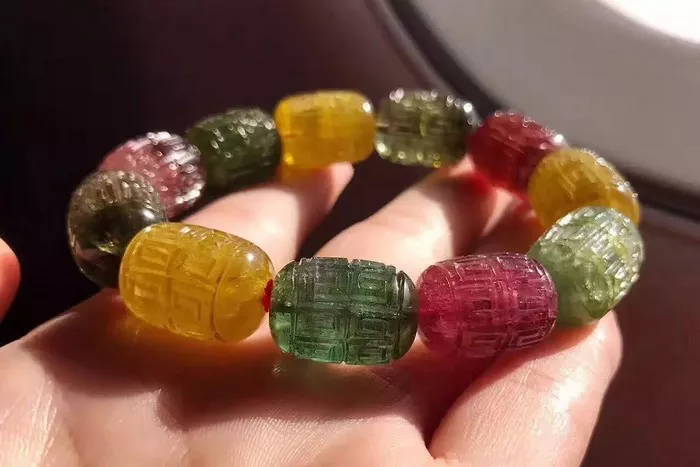Tourmaline, with its kaleidoscopic hues and fascinating origins, has captivated gem enthusiasts for centuries. Among its diverse range, multi-color tourmaline stands out as a mesmerizing display of nature’s artistic prowess. In this article, we delve into the captivating world of multi-color tourmaline, exploring its color variations, origin and formation, physical properties, metaphysical and healing properties, jewelry use, and care and maintenance.
Color Variations:
Multi-color tourmaline, also known as rainbow tourmaline or watermelon tourmaline, exhibits a stunning array of colors, making each gemstone a unique masterpiece. The most common hues found in multi-color tourmaline include green, pink, blue, yellow, and brown, often appearing in vibrant or pastel shades.
Green tourmaline, ranging from pale mint to deep forest green, derives its color from traces of iron within the crystal structure. Pink tourmaline, also known as rubellite, owes its delicate hue to manganese. Blue tourmaline, or indicolite, manifests in shades ranging from sky blue to teal, owing its coloration to traces of iron and titanium. Yellow tourmaline, although less common, presents in shades from pale lemon to golden yellow, attributed to iron and manganese impurities. Brown tourmaline, often referred to as dravite, ranges from light tan to deep chocolate brown, with variations caused by iron and magnesium.
Rare and prized color combinations, such as the iconic watermelon tourmaline, feature a striking juxtaposition of pink and green hues within the same crystal. These bicolor or tricolor specimens are highly coveted by collectors and connoisseurs for their exceptional beauty and rarity.
Origin and Formation:
Tourmaline is a mineral group comprising several distinct species, each with its own unique composition and color variations. It forms in a variety of geological settings, including pegmatites, metamorphic rocks, and hydrothermal veins. The intricate interplay of chemical elements and environmental conditions during crystallization gives rise to tourmaline’s diverse spectrum of colors and properties.
Multi-color tourmaline is typically found in pegmatite deposits, which are coarse-grained igneous rocks formed from the crystallization of magma deep within the Earth’s crust. These deposits often occur in association with granite intrusions and are renowned for their rich diversity of minerals. Specific locations known for producing high-quality multi-color tourmaline include Brazil, Afghanistan, Mozambique, Nigeria, and the United States, particularly the state of Maine.
Physical Properties:
Multi-color tourmaline exhibits a range of physical properties that contribute to its allure and durability. With a hardness of 7 to 7.5 on the Mohs scale, it boasts excellent scratch resistance, making it suitable for everyday wear in jewelry. Its refractive index, ranging from approximately 1.614 to 1.666, imparts exceptional brilliance and fire to faceted gemstones.
One of the most intriguing features of multi-color tourmaline is its pleochroism, the ability to display different colors when viewed from different angles. This optical phenomenon adds depth and dimension to the gemstone, enhancing its visual appeal and mystique. Additionally, multi-color tourmaline exhibits a specific gravity ranging from 3.02 to 3.26, providing gemologists with valuable diagnostic information for gemstone identification.
Metaphysical and Healing Properties:
Beyond its aesthetic allure, multi-color tourmaline is imbued with metaphysical properties that resonate with spiritual seekers and alternative healers. In holistic traditions, tourmaline is revered for its protective qualities and energetic alignment properties. It is believed to create a shield against negative energies and promote a sense of balance and harmony within the body and mind.
Each color variation of tourmaline is associated with specific chakras and metaphysical attributes. Green tourmaline is linked to the heart chakra, fostering compassion and emotional healing. Pink tourmaline resonates with the crown and heart chakras, promoting love, joy, and spiritual growth. Blue tourmaline activates the throat chakra, facilitating clear communication and self-expression. Yellow tourmaline stimulates the solar plexus chakra, enhancing confidence and personal power. Brown tourmaline grounds and stabilizes energy, fostering a sense of security and resilience.
Jewelry Use:
Multi-color tourmaline’s captivating beauty and versatility make it a popular choice for jewelry designers and enthusiasts alike. Its wide range of colors and unique optical properties offer endless possibilities for creative expression. Multi-color tourmaline is commonly fashioned into faceted gemstones for use in rings, necklaces, earrings, and bracelets.
Popular cuts for multi-color tourmaline include emerald, oval, pear, and cushion cuts, which showcase the gemstone’s brilliance and color saturation. Cabochon-cut tourmalines are also favored for their smooth, polished surfaces, particularly in watermelon tourmaline specimens. When it comes to settings, both traditional prong settings and modern bezel settings are employed to highlight the gemstone’s natural beauty and protect it from damage.
Care and Maintenance:
To ensure the longevity and luster of multi-color tourmaline jewelry, proper care and maintenance are essential. Avoid exposing tourmaline to harsh chemicals, extreme temperatures, or sudden changes in temperature, as these can cause damage or discoloration. To clean tourmaline jewelry, gently scrub the gemstones with a soft brush and mild soapy water, taking care to rinse thoroughly and dry with a soft cloth.
Regularly inspect tourmaline jewelry for any signs of damage or loose settings, and promptly address any issues to prevent further damage. When not being worn, store tourmaline jewelry separately from other gemstones to prevent scratches and abrasions. With proper care, multi-color tourmaline jewelry can be enjoyed for generations to come, serving as a timeless testament to nature’s exquisite artistry.
Conclusion:
Multi-color tourmaline, with its enchanting hues and metaphysical properties, embodies the splendor of nature’s creativity. From its diverse color variations to its origin and formation deep within the Earth’s crust, each facet of multi-color tourmaline reveals a captivating story of geological evolution and artistic expression. Whether adorning the body as jewelry or serving as a talisman of spiritual protection, multi-color tourmaline continues to inspire awe and wonder, inviting us to marvel at the boundless beauty of the natural world.


